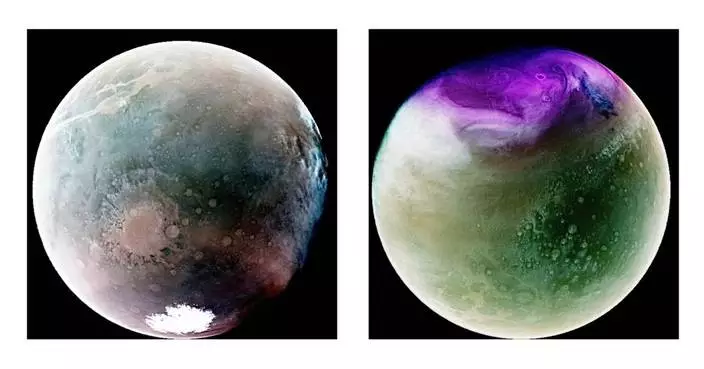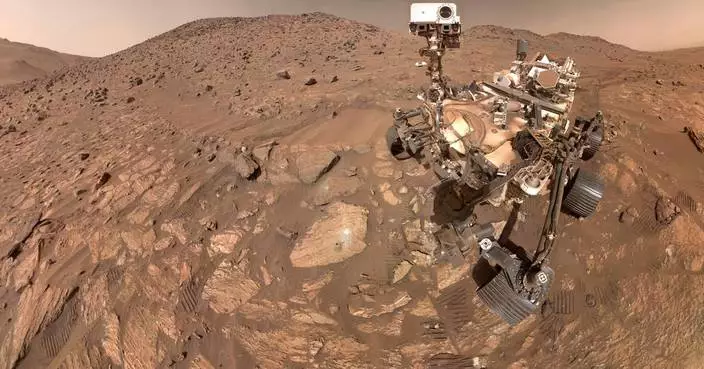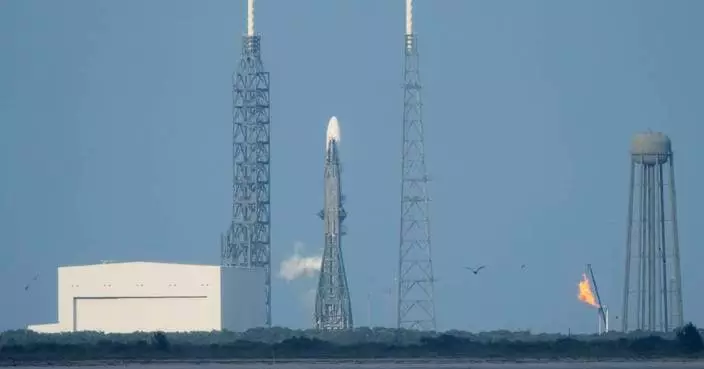Two scientists in spacesuits, stark white against the auburn terrain of desolate plains and dunes, test a geo-radar built to map Mars by dragging the flat box across the rocky sand.
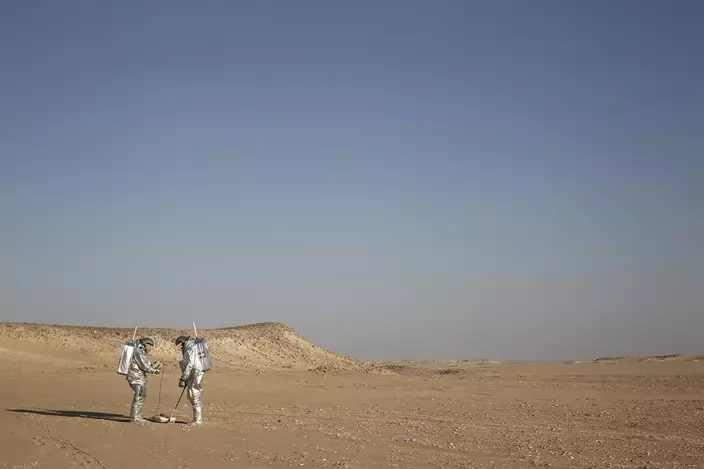
In this Feb. 7, 2018, photo, two scientists test space suits and a geo-radar for use in a future Mars mission in the Dhofar desert of southern Oman. (AP Photo/Sam McNeil)
When the geo-radar stops working, the two walk back to their all-terrain vehicles and radio colleagues at their nearby base camp for guidance. They can't turn to their mission command, far off in the Alps, because communications from there are delayed 10 minutes.
Click to Gallery
In this Feb. 7, 2018, photo, two scientists test space suits and a geo-radar for use in a future Mars mission in the Dhofar desert of southern Oman. (AP Photo/Sam McNeil)
In this Feb. 7, 2018, photo, two scientists test space suits and a geo-radar for use in a future Mars mission in the Dhofar desert of southern Oman. (AP Photo/Sam McNeil)
This Feb. 7, 2018, photo shows João Lousada, a flight controller for the International Space Station, wearing an experimental space suit during a simulation of a future Mars mission in the Dhofar desert of southern Oman. (AP Photo/Sam McNeil)
This Feb. 7, 2018, photo shows João Lousada, a flight controller for the International Space Station, wearing an experimental space suit during a simulation of a future Mars mission in the Dhofar desert of southern Oman. (AP Photo/Sam McNeil)
This Feb. 7, 2018, photo shows analog astronaut Kartik Kumar wearing an experimental space suit during a simulation of a future Mars mission in the Dhofar desert of southern Oman. (AP Photo/Sam McNeil)
This Feb. 7, 2018, photo shows João Lousada, a flight controller for the International Space Station, wearing an experimental space suit during a simulation of a future Mars mission in the Dhofar desert of southern Oman. (AP Photo/Sam McNeil)
This Feb. 7, 2018, photo shows João Lousada, a flight controller for the International Space Station, wearing an experimental space suit during a simulation of a future Mars mission in the Dhofar desert of southern Oman. (AP Photo/Sam McNeil)
This Feb. 7, 2018, photo shows analog astronaut Kartik Kumar wearing an experimental space suit during a simulation of a future Mars mission in the Dhofar desert of southern Oman. (AP Photo/Sam McNeil)
In this Feb. 7, 2018, photo, analog astronaut João Lousada, center, hands his colleague Kartik Kumar a drone while two Omani men watching in front of the Mars simulation base camp in the Dhofar desert of Oman. (AP Photo/Sam McNeil)
The sun rises over a 2.4-ton inflated habitat used by the AMADEE-18 Mars simulation in the Dhofar desert of southern Oman on Thursday, Feb. 8, 2018. (AP Photo/Sam McNeil)
But this isn't the red planet — it's the Arabian Peninsula.
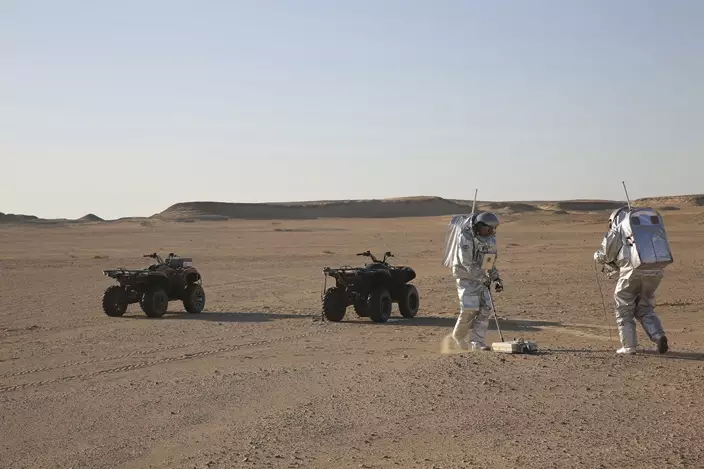
In this Feb. 7, 2018, photo, two scientists test space suits and a geo-radar for use in a future Mars mission in the Dhofar desert of southern Oman. (AP Photo/Sam McNeil)
The desolate desert in southern Oman, near the borders of Yemen and Saudi Arabia, resembles Mars so much that more than 200 scientists from 25 nations chose it as their location for the next four weeks, to field-test technology for a manned mission to Mars.
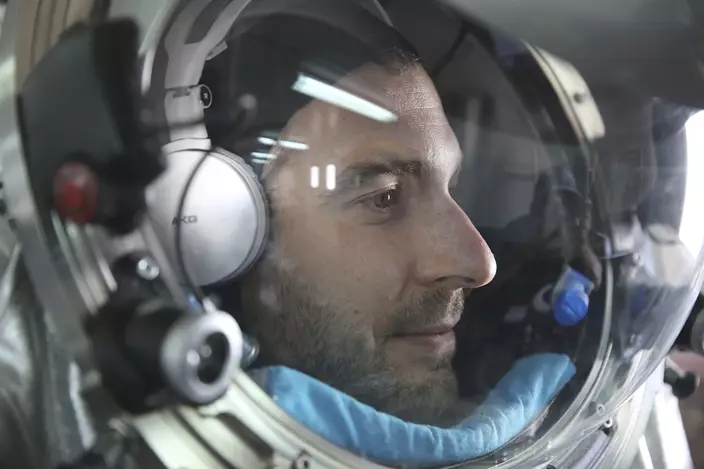
This Feb. 7, 2018, photo shows João Lousada, a flight controller for the International Space Station, wearing an experimental space suit during a simulation of a future Mars mission in the Dhofar desert of southern Oman. (AP Photo/Sam McNeil)
Public and private ventures are racing toward Mars — both former President Barack Obama and SpaceX founder Elon Musk declared humans would walk on the red planet in a few decades.
New challengers like China are joining the United States and Russia in space with an ambitious, if vague, Mars program. Aerospace corporations like Blue Origin have published schematics of future bases, ships, and suits.
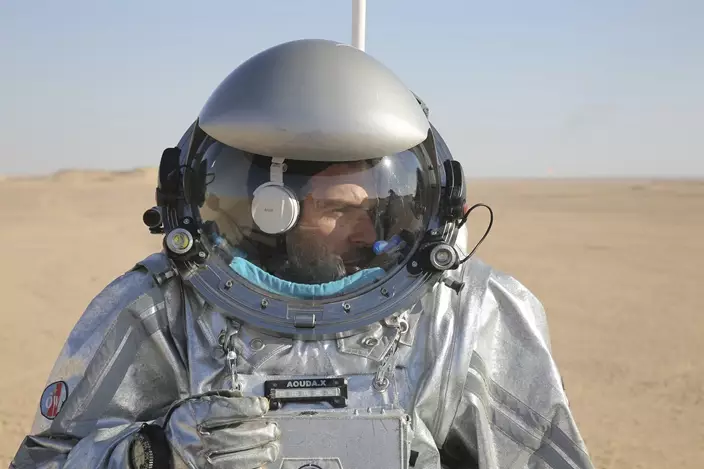
This Feb. 7, 2018, photo shows João Lousada, a flight controller for the International Space Station, wearing an experimental space suit during a simulation of a future Mars mission in the Dhofar desert of southern Oman. (AP Photo/Sam McNeil)
The successful launch of SpaceX Falcon Heavy rocket this week "puts us in a completely different realm of what we can put into deep space, what we can send to Mars," said analog astronaut Kartik Kumar.
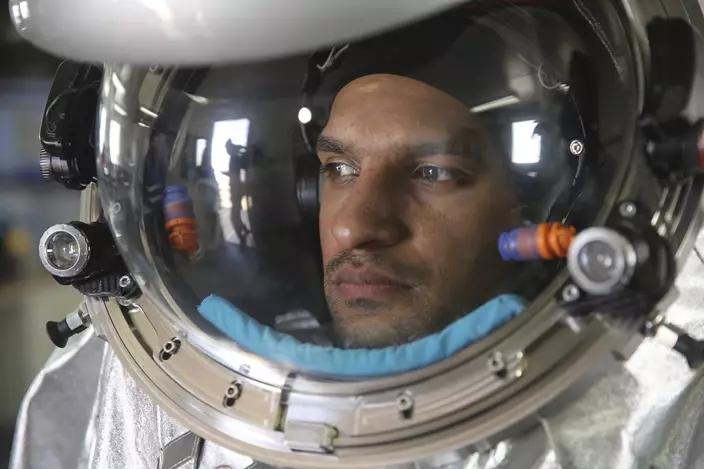
This Feb. 7, 2018, photo shows analog astronaut Kartik Kumar wearing an experimental space suit during a simulation of a future Mars mission in the Dhofar desert of southern Oman. (AP Photo/Sam McNeil)
The next step to Mars, he says, is to tackle non-engineering problems like medical emergency responses and isolation.
"These are things I think can't be underestimated," Kumar said.
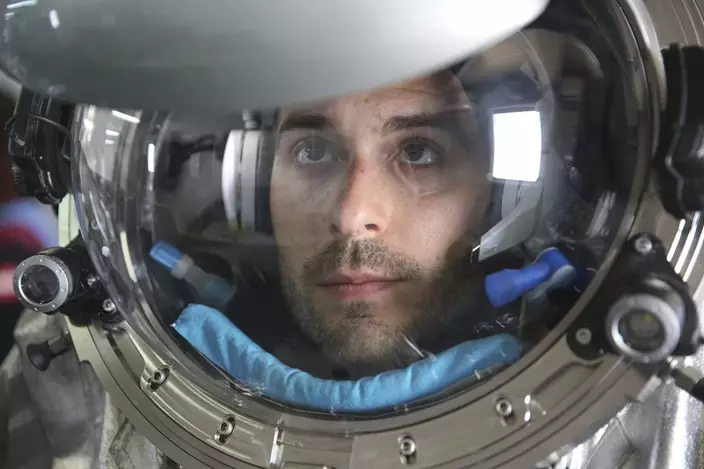
This Feb. 7, 2018, photo shows João Lousada, a flight controller for the International Space Station, wearing an experimental space suit during a simulation of a future Mars mission in the Dhofar desert of southern Oman. (AP Photo/Sam McNeil)
While cosmonauts and astronauts are learning valuable spacefaring skills on the International Space Station — and the U.S. is using virtual reality to train scientists — the majority of work to prepare for interplanetary expeditions is being done on Earth.
And where best to field-test equipment and people for the journey to Mars but on some of the planet's most forbidding spots?
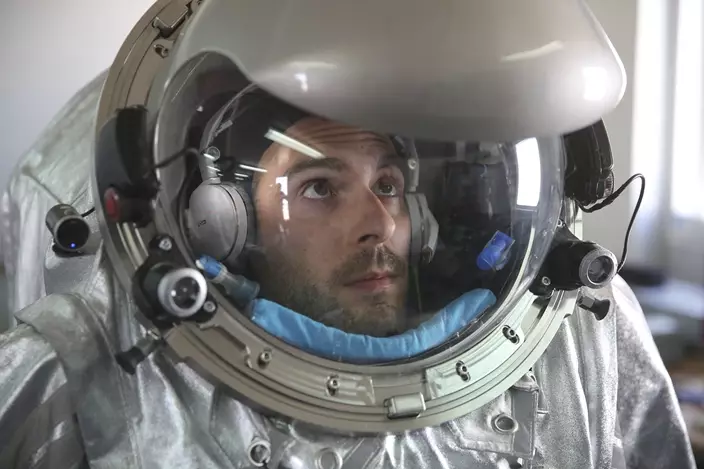
This Feb. 7, 2018, photo shows João Lousada, a flight controller for the International Space Station, wearing an experimental space suit during a simulation of a future Mars mission in the Dhofar desert of southern Oman. (AP Photo/Sam McNeil)
Seen from space, the Dhofar Desert is a flat, brown expanse. Few animals or plants survive in the desert expanses of the Arabian Peninsula, where temperatures can top 125 degrees Fahrenheit, or 51 degrees Celsius.
On the eastern edge of a seemingly endless dune is the Oman Mars Base: a giant 2.4-ton inflated habitat surrounded by shipping containers turned into labs and crew quarters.
There are no airlocks.
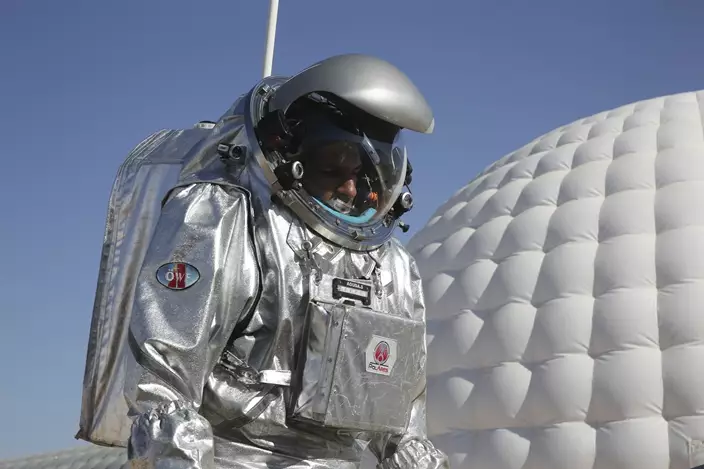
This Feb. 7, 2018, photo shows analog astronaut Kartik Kumar wearing an experimental space suit during a simulation of a future Mars mission in the Dhofar desert of southern Oman. (AP Photo/Sam McNeil)
The desert's surface resembles Mars so much, it's hard to tell the difference, Kumar said, his spacesuit caked in dust. "But it goes deeper than that: the types of geomorphology, all the structures, the salt domes, the riverbeds, the wadis, it parallels a lot of what we see on Mars."
The Omani government offered to host the Austrian Space Forum's next Mars simulation during a meeting of the United Nation's Committee On the Peaceful Uses of Outer Space.
Gernot Groemer, the commander of the Oman Mars simulation and a veteran of 11 science missions on Earth, said the forum quickly accepted.
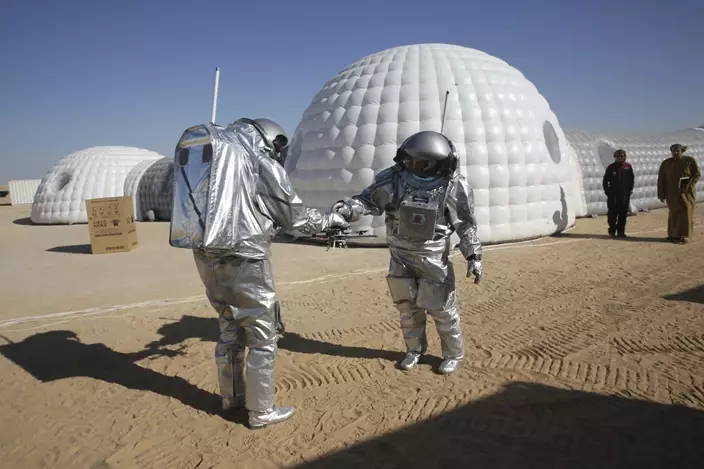
In this Feb. 7, 2018, photo, analog astronaut João Lousada, center, hands his colleague Kartik Kumar a drone while two Omani men watching in front of the Mars simulation base camp in the Dhofar desert of Oman. (AP Photo/Sam McNeil)
Scientists from across the world sent ideas for experiments and the mission, named AMADEE-18, quickly grew to 16 scientific experiments, such as testing a "tumbleweed" whip-fast robot rover and a new spacesuit called Aouda.
The cutting-edge spacesuit, weighing about 50 kilograms (110 pounds), is called a "personal spaceship" because one can breathe, eat and do hard science inside it. The suit's visor displays maps, communications, and sensor data. A blue piece of foam in front of the chin can be used to wipe your nose and mouth.
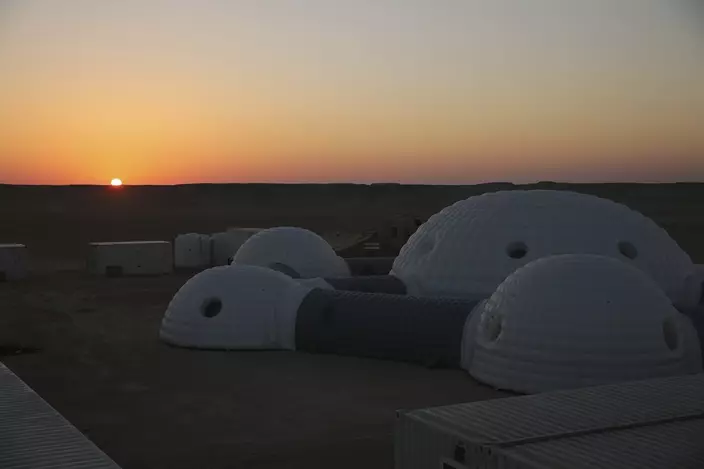
The sun rises over a 2.4-ton inflated habitat used by the AMADEE-18 Mars simulation in the Dhofar desert of southern Oman on Thursday, Feb. 8, 2018. (AP Photo/Sam McNeil)
"No matter who is going to this grandest voyage of our society yet to come, I think a few things we learn here will be actually implemented in those missions," Groemer said.
The Soviet Union's 1957 launch of Sputnik ignited a space race between Moscow and Washington to land a crew on the Moon.
But before the U.S. got there first, astronauts like Neil Armstrong trained suspended on pulleys to simulate one-sixth of Earth's gravity.
Hostile environments from Arizona to Siberia were used to fine-tune capsules, landers, rovers, and suits — simulating otherworldly dangers to be found beyond Earth. Space agencies call them "analogues" because they resemble extraterrestrial extremes of cold and remoteness.
"You can test systems on those locations and see where the breaking points are, and you can see where things start to fail and which design option you need to take in order to assure that it does not fail on Mars," said João Lousada, one of the Oman simulation's deputy field commanders who is a flight controller for the space station.
Faux space stations have been built underwater off the coast of Florida, on frigid dark deserts of Antarctica, and in volcanic craters in Hawaii, according to "Packing For Mars," a favorite book among many Mars scientists, written by Mary Roach.
"Terrestrial analogs are a tool in the toolkit of space exploration, but they are not a panacea," said Scott Hubbard, known as "Mars czar" back when he leads the U.S. space agency's Mars program. Some simulations have helped developed cameras, rovers, suits and closed-loop life-support systems, he said.
NASA used the Mojave Desert to test rovers destined for the red planet but they also discovered much about how humans can adapt.
"Human's adaptability in an unstructured environment is still far, far better than any robot we can send to space," Hubbard said, adding that people, not just robots, are the key to exploring Mars.
The European Space Agency's list of "planetary analogues" includes projects in Chile, Peru, South Africa, Namibia, Morocco, Italy, Spain, Canada, Antarctica, Russia, China, Australia, India, Germany, Norway, Iceland, and nine U.S. states. Next Thursday, Israeli scientists are to run a shorter simulation in a nature preserve called D Mars.
However, there remain so many unknowns that simulations "are not in any way a replacement for being there," Hubbard said.
The Oman team's optimism is unflinching.
"The first person to walk on Mars has in fact already been born, and might be going to elementary school now in Oman, or back in Europe, in the U.S. or China," Lousada said.
WASHINGTON (AP) — President Donald Trump said Wednesday that the United States has seized an oil tanker off the coast of Venezuela as tensions mount with the government of President Nicolás Maduro.
Using U.S. forces to take control of a merchant ship is incredibly unusual and marks the Trump administration’s latest push to increase pressure on Maduro, who has been charged with narcoterrorism in the United States. The U.S. has built up the largest military presence in the region in decades and launched a series of deadly strikes on alleged drug-smuggling boats in the Caribbean Sea and eastern Pacific Ocean. The campaign is facing growing scrutiny from Congress.
“We’ve just seized a tanker on the coast of Venezuela, a large tanker, very large, largest one ever seized, actually,” Trump told reporters at the White House, later adding that "it was seized for a very good reason.”
Trump did not offer additional details. When asked what would happen to the oil aboard the tanker, Trump said, “Well, we keep it, I guess.”
The seizure was led by the U.S. Coast Guard and supported by the Navy, according to a U.S. official who was not authorized to comment publicly and spoke on the condition of anonymity. The official added that it was conducted under U.S. law enforcement authority.
The Coast Guard members were taken to the oil tanker by helicopter from the aircraft carrier USS Gerald R. Ford, the official said. The Ford is in the Caribbean Sea after arriving last month in a major show of force, joining a fleet of other warships.
Video posted to social media by Attorney General Pam Bondi shows people fast-roping from one of the helicopters involved in the operation as it hovers just feet from the deck.
The Coast Guard members can be seen later in the video moving throughout the superstructure of the ship with their weapons drawn.
Bondi wrote that “for multiple years, the oil tanker has been sanctioned by the United States due to its involvement in an illicit oil shipping network supporting foreign terrorist organizations.”
Venezuela’s government said in a statement that the seizure “constitutes a blatant theft and an act of international piracy.”
“Under these circumstances, the true reasons for the prolonged aggression against Venezuela have finally been revealed. … It has always been about our natural resources, our oil, our energy, the resources that belong exclusively to the Venezuelan people,” the statement said.
The U.S. official identified the seized tanker as the Skipper.
The ship departed Venezuela around Dec. 2 with about 2 million barrels of heavy crude, roughly half of it belonging to a Cuban state-run oil importer, according to documents from the state-owned company Petróleos de Venezuela S.A., commonly known as PDVSA, that were provided on the condition of anonymity because the person did not have permission to share them.
The Skipper was previously known as the M/T Adisa, according to ship tracking data. The Adisa was sanctioned by the U.S. in 2022 over accusations of belonging to a sophisticated network of shadow tankers that smuggled crude oil on behalf of Iran’s Revolutionary Guard and Lebanon's Hezbollah militant group.
The network was reportedly run by a Switzerland-based Ukrainian oil trader, the U.S. Treasury Department said at the time.
Venezuela has the world’s largest proven oil reserves and produces about 1 million barrels a day.
PDVSA is the backbone of the country’s economy. Its reliance on intermediaries increased in 2020, when the first Trump administration expanded its maximum-pressure campaign on Venezuela with sanctions that threaten to lock out of the U.S. economy any individual or company that does business with Maduro’s government. Longtime allies Russia and Iran, both also sanctioned, have helped Venezuela skirt restrictions.
The transactions usually involve a complex network of shadowy intermediaries. Many are shell companies, registered in jurisdictions known for secrecy. The buyers deploy so-called ghost tankers that hide their location and hand off their valuable cargoes in the middle of the ocean before they reach their final destination.
Maduro did not address the seizure during a speech before a ruling-party organized demonstration in Caracas, Venezuela’s capital. But he told supporters that the country is “prepared to break the teeth of the North American empire if necessary.”
Maduro has insisted the real purpose of the U.S. military operations is to force him from office.
Sen. Chris Van Hollen, D-Md., a member of the Senate Foreign Relations Committee, said the U.S. seizing the oil tanker cast doubt on the administration’s stated reasons for the military buildup and boat strikes.
“This shows that their whole cover story — that this is about interdicting drugs — is a big lie,” the senator said. “This is just one more piece of evidence that this is really about regime change — by force.”
Vincent P. O’Hara, a naval historian and author of “The Greatest Naval War Ever Fought,” called the seizure “very unusual” and "provocative." Noting that the action will probably deter other ships from the Venezuela coastline, he said, "If you have no maritime traffic or access to that, then you have no economy.”
The seizure comes a day after the U.S. military flew a pair of fighter jets over the Gulf of Venezuela in what appeared to be the closest that warplanes had come to the South American country’s airspace. Trump has said land attacks are coming soon but has not offered more details.
The Trump administration is facing increasing scrutiny from lawmakers over the boat strike campaign, which has killed at least 87 people in 22 known strikes since early September, including a follow-up strike that killed two survivors clinging to the wreckage of a boat after the first hit.
Some legal experts and Democrats say that action may have violated the laws governing the use of deadly military force.
Lawmakers are demanding to get unedited video from the strikes, but Defense Secretary Pete Hegseth told congressional leaders at a classified briefing Tuesday that he was still weighing whether to release it.
The Coast Guard referred a request for comment about the tanker seizure to the White House.
Goodman reported from Miami, and Garcia Cano from Caracas, Venezuela. Associated Press writers Lisa Mascaro and Alanna Durkin Richer in Washington, Rebecca Boone in Boise, Idaho, and Susan Haigh in Hartford, Connecticut, contributed to this report.

This image from video posted on Attorney General Pam Bondi's X account, and partially redacted by the source, shows an oil tanker being seized by U.S. forces off the coast of Venezuela, Wednesday, Dec. 10, 2025. (U.S. Attorney General's Office/X via AP)

This image from video posted on Attorney General Pam Bondi's X account, and partially redacted by the source, shows an oil tanker being seized by U.S. forces off the coast of Venezuela, Wednesday, Dec. 10, 2025. (U.S. Attorney General's Office/X via AP)

Nicolas Maduro speaks at a rally marking the anniversary of the Battle of Santa Isabel, which took place during Venezuela's 19th-century Federal War, in Caracas, Venezuela, Wednesday, Dec. 10, 2025. (AP Photo/Ariana Cubillos)

President Donald Trump speaks during a roundtable in the Roosevelt Room of the White House, Wednesday, Dec. 10, 2025, in Washington. (AP Photo/Evan Vucci)

















